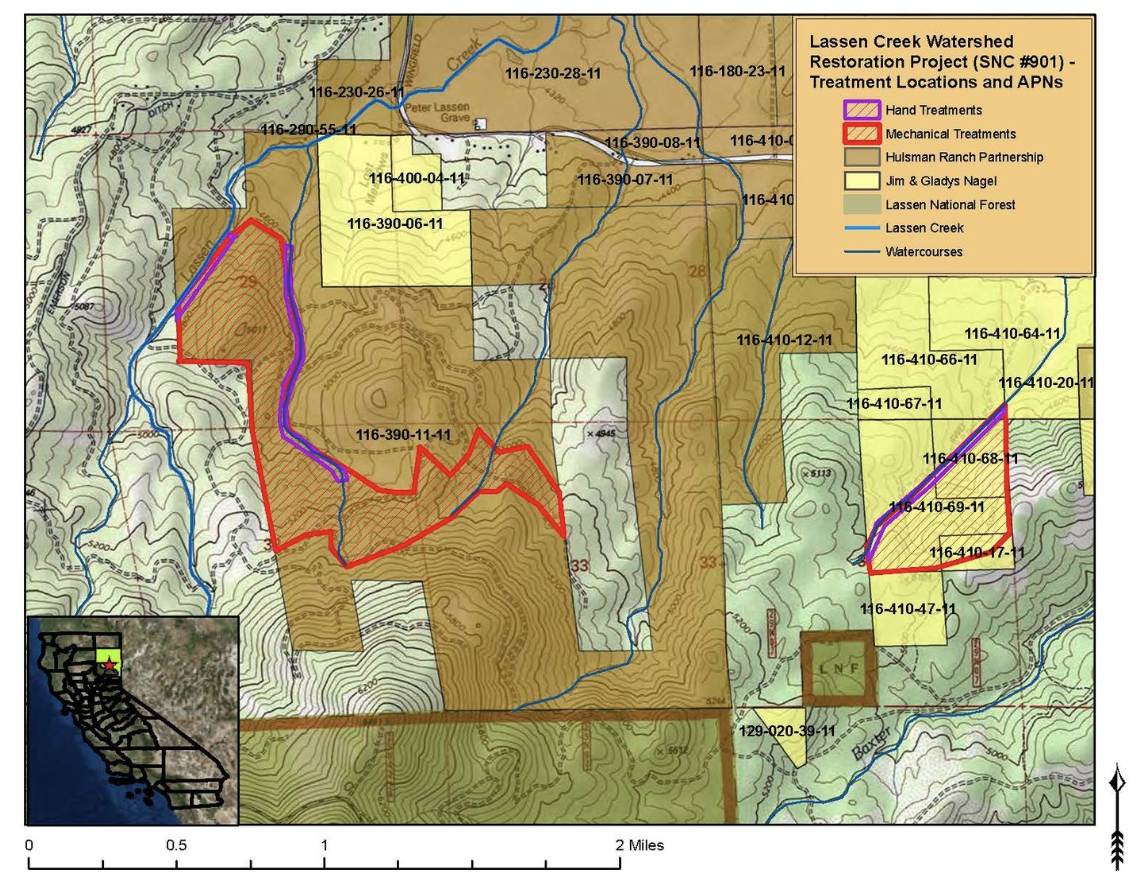Lassen Creek Watershed Restoration
California voters passed Proposition 1, The Water Quality, Supply, and Infrastructure Improvement Bond Act of 2014, on November 4, 2014. Proposition 1 added Section 79731 to the California Water Code, authorizing the state to issue bonds, and the legislature to appropriate the proceeds, for multi-benefit water quality, water supply, and watershed protection and restoration projects for the watersheds of the state. The bond measure included an allocation of $25 million for the Sierra Nevada Conservancy (SNC). During SNC's 3rd round of funding, the Honey Lake Valley RCD was successfully awarded $250,000 for project 901: Lassen Creek Watershed Restoration Project.

Location: The project area lies within the Lassen Creek watershed immediately north of the Lassen National Forest (LNF) boundary and south of Wingfield Road, and falls within the Susanville Wildland Urban Interface (WUI) zone for the City of Susanville in Lassen County, California. Lassen Creek, the main drainage within the watershed, is a tributary to the Susan River. Many agricultural producers within the Honey Lake Valley have water rights on Lassen Creek and the Susan River. The Susan River drains into the Honey Lake Wildlife Area, a 7,667 acre wetland managed by the California Department of Fish and Wildlife (CDFW) at the mouth of the Susan River on the north end of Honey Lake. This project will result in an increase in water availability through a reduction in living plant matter and reduction in evapotranspiration due to more precipitation reaching the ground. This increased water availability will improve water quality and will be available for irrigation of crops, groundwater recharge, and improved riparian ecosystem function.
Summary and Scope: The main purpose of this project is to produce a healthier forest condition and reduce the risk and potential harmful impacts of large, damaging fires by restoring and enhancing ponderosa pine, Sierran mixed conifer, quaking aspen, and California black oak ecosystems on a 325-acre project site within the Lassen Creek watershed. This will be accomplished with a multitude of forest management tools including: mechanical harvesting(+/- 300 acres) of conifers under 12" diameter; and hand thinning, pruning, mastication, and slash disposal near residential areas, along access corridors, and along sensitive watercourses(+/- 25 acres). Woody debris and biomass generated will be utilized to the maximum extent feasible for chips to be delivered to a waste generation facility or for fuel-wood.
The RCD has implemented 800 acres of fuel reduction within the project area over the last five years. This project is strategically located to tie into past RCD projects as well as work that is being planed by the LNF and Lassen County Fire Safe Council (with support from SNC) along the southern boundary of the Hulsman Ranch and Red River lands.
Intended Results:
- Increase in water availability and storage through the reduction of living plants in· overstocked conifer stands, and removal of encroaching young conifer trees in native grass meadows;
- Reduce the threat of catastrophic wildfire through the reduction of woody biomass and ladder fuels;
- Reduce the risk to and improved safety for residences and emergency personnel in the event of a wildfire within a portion of the Susanville WUI
- Protect homes and a historic cemetery along Wingfield Rd from the threat of wildfire.
- Reduce the risk of insect infestation and resulting tree mortality by decreasing stand density
- Improve conifer tree health and growth by thinning overly dense young trees that will enhance the long-term productivity of the forest;
- Restore conifer forest ecosystems to a more open condition while providing for a diverse array of habitat niches;
- Improve wildlife habitat diversity for hardwood species ( quaking aspen and CA black oak) by reducing competition from conifers;
- Protect soil resources;
- Utilize woody biomass for energy production;
- Reduce the wildfire threat to a designated Spotted Owl Habitat Area adjacent to the project area on the LNF.
